Ever looked at your postage stamp of a deck and wondered how anyone could possibly create a functional, stylish space in such limited square footage?
Trust me, you’re not alone!
When my partner and I moved into our first place with an actual outdoor area (all 78 square feet of it!), I nearly gave up before I started.
But here’s the thing about small decks – they’re not limiting, they’re just cozy by default!
The secret lies in being intentional about every single item you bring into the space.
That rustic farmhouse table that caught your eye?
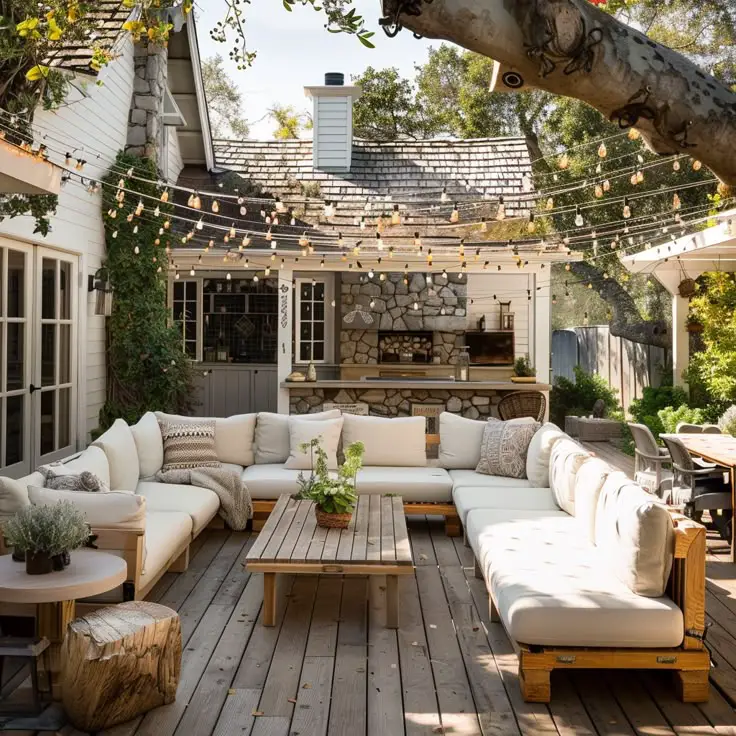
Amazing, but maybe not for a 6×8 deck.
Instead, think foldable bistro sets that can tuck away when not needed, or bench seating that doubles as storage.
Multi-functionality is your best friend here.
Look for ottomans that serve as extra seating and side tables, wall-mounted folding tables, or stackable stools that can disappear when not entertaining.
Even your planters can work double-duty by incorporating built-in seating or serving as privacy screens.
Vertical space is also criminally underutilized on small decks.
Wall-mounted planters, hanging lights, and fold-down tables can free up precious floor space while still adding character and functionality.
And don’t be afraid of creating zones!
Even on my tiny deck, I carved out a dining nook and a separate lounging area with a compact loveseat.
Now let’s walk through my favorite layout ideas that have worked wonders for fellow small-deck owners:
✨Click to Get My 101 FREE Designer Room Ideas
1. The Conversation Corner
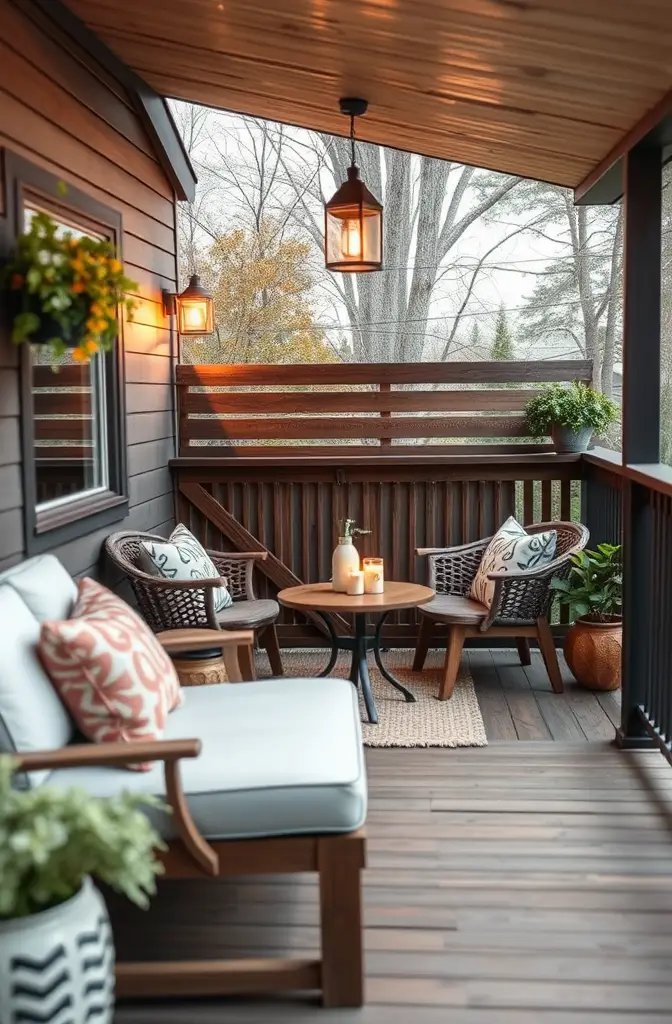
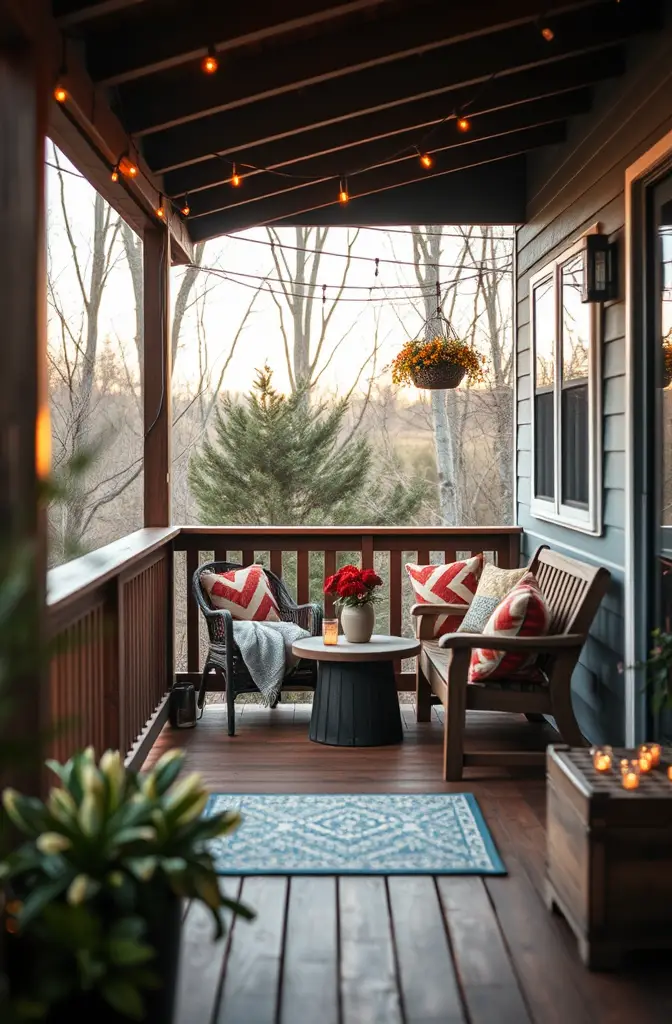
Looking to maximize social interaction in a minimal footprint?
A conversation corner might be your perfect solution.
Creating a cozy conversation nook on your small deck can transform the entire feel of your outdoor space.
Choose a compact loveseat or a small outdoor sofa and position it in one corner of your deck.
Add one or two chairs at a 90-degree angle to create an intimate L-shaped seating arrangement that naturally encourages conversation.
Small outdoor ottomans can serve triple duty as footrests, extra seating, and even side tables when topped with a tray.
Consider furniture with slimmer profiles and open designs that won’t visually overwhelm your small deck.
Armless chairs can save precious inches while still providing comfortable seating.
Weather-resistant fabrics in light colors can make the space feel more open and airy.
A small coffee table in the center pulls the arrangement together without requiring much space.
Look for round tables rather than square ones to improve flow around the seating area.
Hanging string lights overhead creates ambiance without taking up any deck space at all.
Consider wall-mounted lighting options if your deck has suitable surfaces for installation.
This arrangement works particularly well in a corner deck, where the railings can serve as natural boundaries for your seating area.
2. The Dining Deck Transformation
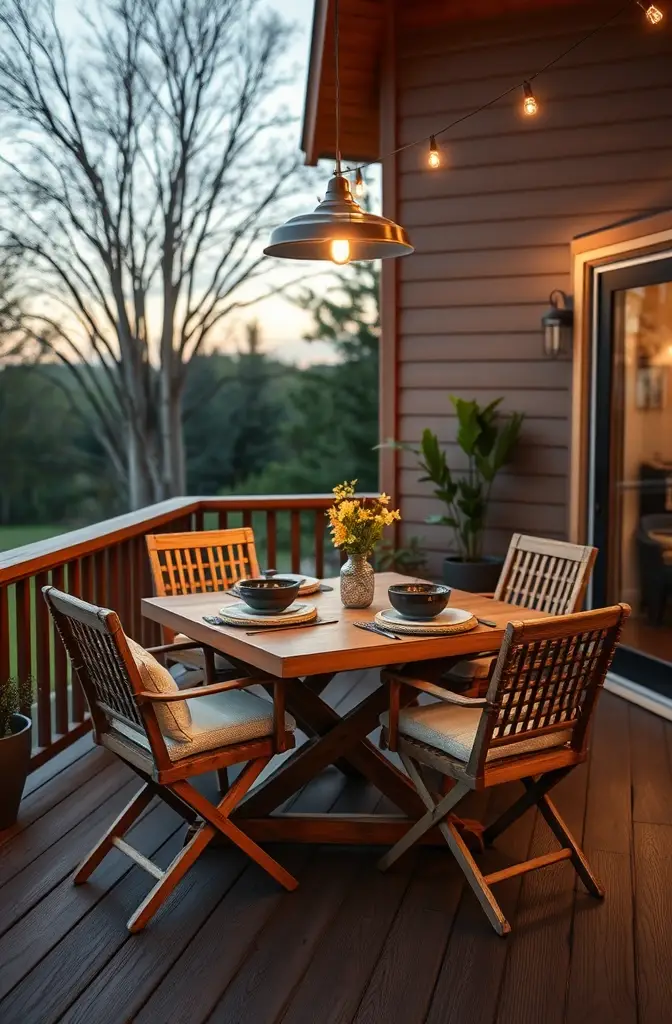
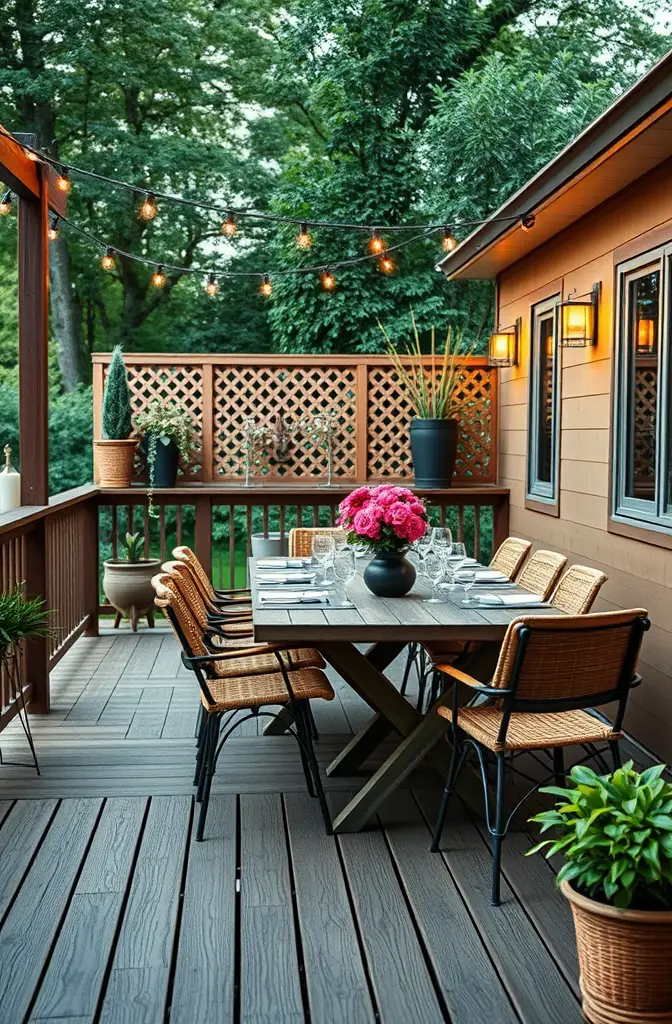
Who says you can’t have a proper dining setup on a small deck?
With the right approach, outdoor meals can become a daily joy.
Start with a bistro-style table that offers enough surface area for meals without hogging your deck space.
Round tables generally work better than rectangular ones in tight spaces since they eliminate sharp corners to navigate around.
Folding chairs are your best friends for small deck dining areas—they can be tucked away when not in use.
Consider a drop-leaf or extendable table that can be compact for daily use but expand when you have guests.
Position your dining set against a railing or wall to free up the flow of movement across the rest of the deck.
Built-in bench seating along one side can save significant space compared to having chairs all around the table.
Overhead solutions like a retractable awning or umbrella provide necessary shade without claiming precious floor space.
Slim planters with vertical plants can create a sense of intimacy around your dining area without taking up much room.
Wall-mounted shelving near your dining area can hold serving pieces, allowing you to skip the bulky sideboard.
For evening meals, consider installing sconces rather than taking up table space with lanterns.
A narrow console table that folds down from the wall can serve as a buffet surface when entertaining.
Choose stackable dining chairs that can be easily stored when you need to reclaim deck space for other activities.
Remember that light-colored furniture will make your dining area feel more spacious and won’t absorb as much heat in summer.
3. The Vertical Victory Garden
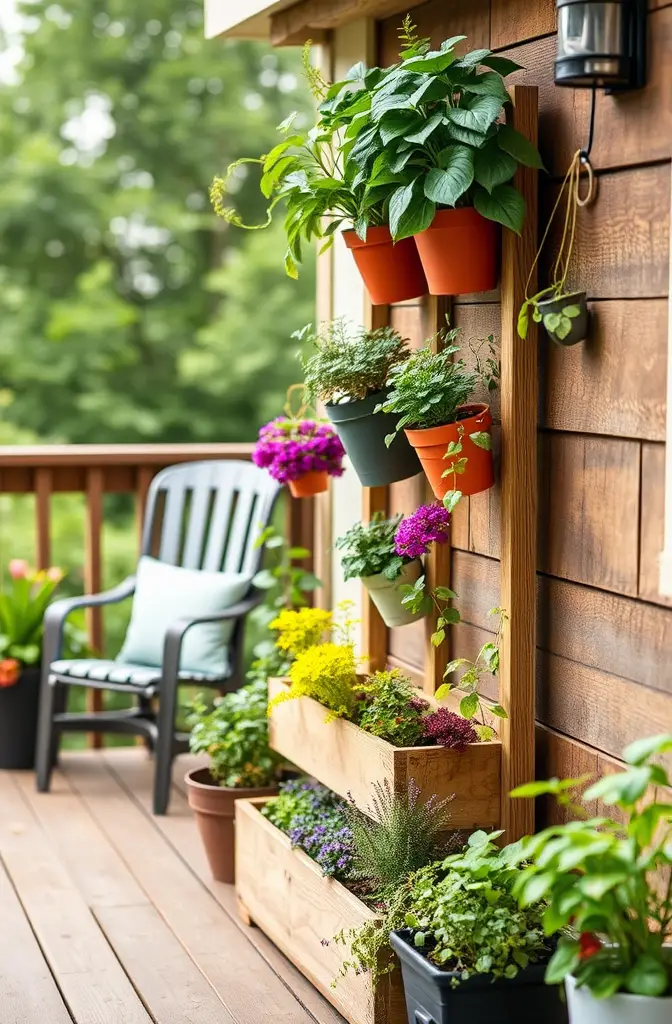
When floor space is limited, the only way to go is up!
A vertical garden setup maximizes your greenery without sacrificing seating area.
Start by assessing which walls or railings get adequate sunlight for the plants you want to grow.
Install wall-mounted planters in a staggered pattern to create visual interest and ensure all plants receive sufficient light.
Tiered plant stands can transform a corner of your deck into a lush garden while having a surprisingly small footprint.
Railing planters that hang on the outside of your deck railings reclaim valuable floor space.
Consider a trellis system that allows climbing plants to create a living privacy screen without taking up deck width.
Hanging baskets suspended from pergolas or overhangs add greenery at eye level while keeping the floor clear.
Vertical herb gardens near your dining area provide both beauty and function—fresh herbs for your outdoor meals.
Use magnetic or suction planters on metal surfaces or glass doors to further maximize your vertical growing space.
Incorporate plants with trailing habits like ivy or pothos to soften edges and create the illusion of a larger green space.
Modular vertical garden systems can be expanded or reconfigured as your needs change throughout the seasons.
Integrate a small folding shelf below your vertical garden to hold watering cans and gardening tools.
Pocket planters made of canvas or recycled materials can create an entire living wall with minimal structural requirements.
Remember to consider weight restrictions when planning your vertical garden—especially for railing installations.
4. The Multi-Functional Ottoman Miracle
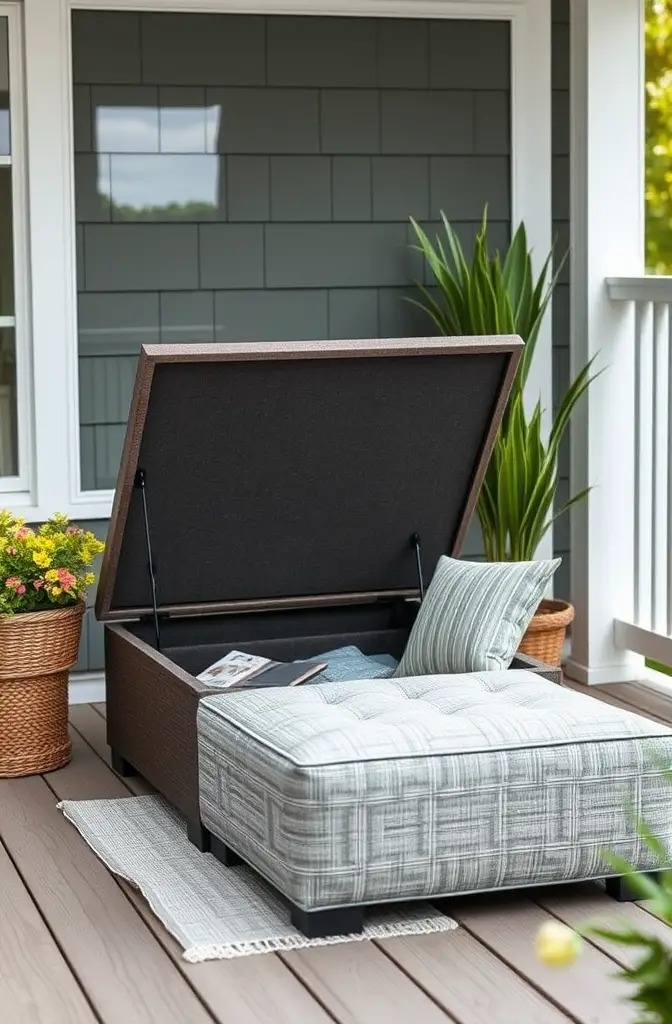
The humble ottoman might be the most underrated piece of small-space furniture ever invented.
Choose an ottoman with hidden storage to keep outdoor essentials tucked away when not in use.
Look for weather-resistant materials that can withstand the elements while still looking stylish.
Position your ottoman to serve as a coffee table during the day by adding a decorative tray on top.
When evening comes, remove the tray and extend your legs for a comfortable lounging experience.
For entertaining, your ottoman transforms into extra seating that can be easily moved where needed.
Consider nesting ottomans of different sizes that can be separated when you have guests and stacked when it’s just you.
A pair of ottomans can be pushed together to create an impromptu loveseat or even a small daybed for afternoon naps.
Choose ottomans with firm, flat tops that can reliably support drinks and small plates without wobbling.
Select styles with removable, washable covers to keep your outdoor furniture looking fresh season after season.
For added versatility, look for convertible ottoman designs that unfold into loungers or additional seating.
Lightweight ottomans can be easily repositioned to follow shade patterns throughout the day.
The most space-efficient option?
An ottoman that serves as hidden storage for a compact grill or outdoor kitchen supplies.
Remember that round ottomans tend to be more space-efficient than square ones since they eliminate sharp corners in tight walkways.
✨Click to Get My 101 FREE Designer Room Ideas
5. The Railing Bar Experience
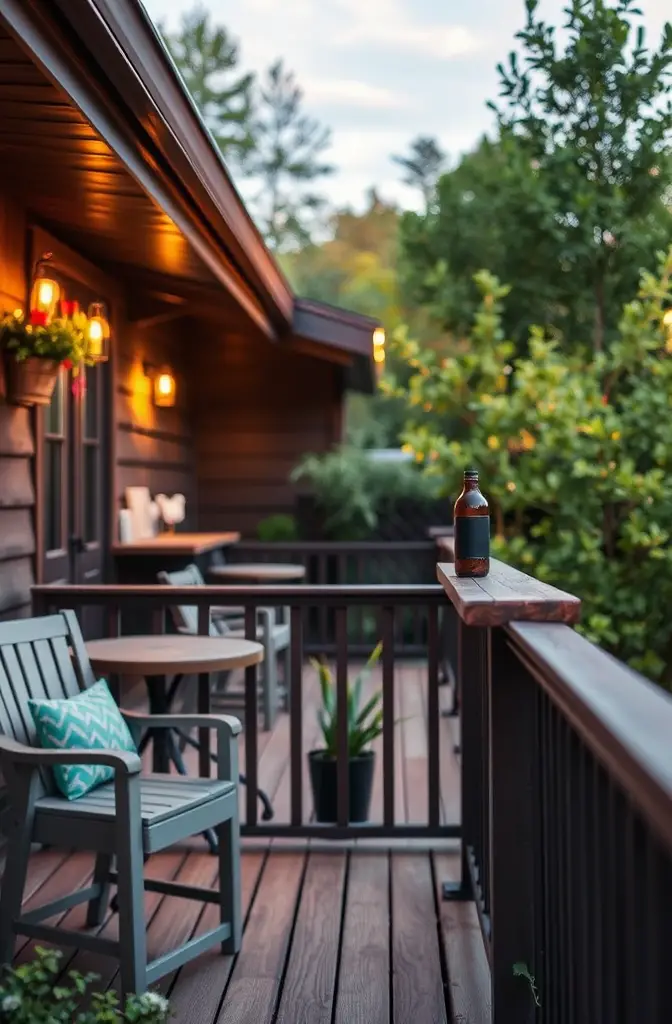
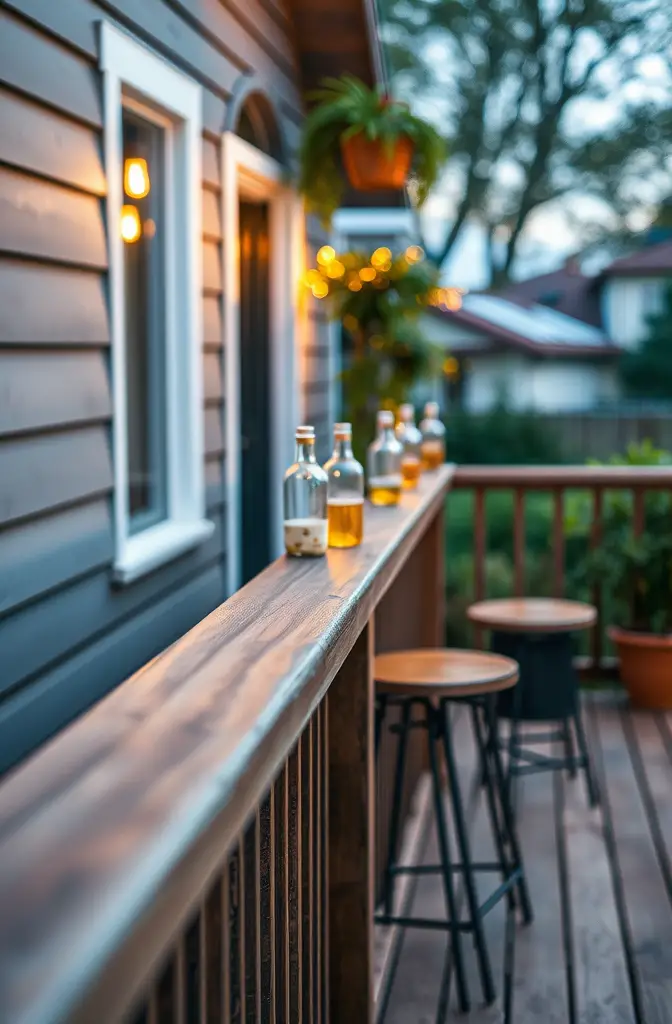
Transform your deck railing from a simple safety feature into valuable entertainment space with a railing bar setup.
Start with a railing-mounted bar top that flips down when not in use to preserve your open space.
This instantly creates a serving area for drinks or a casual dining spot without taking up any floor space.
Add folding bar stools that can be tucked away when the bar is not in use.
Choose stools with slender profiles that won’t clutter your already limited deck area.
Install small railing-mounted planter boxes for herbs that can go straight into your cocktails.
Hanging glass or bottle holders on nearby walls keeps beverages accessible without cluttering your bar surface.
Solar-powered mini lights strung along the railing add ambiance for evening entertaining.
A small hook system underneath the bar top can hold essential bar tools within easy reach.
Consider a drop-leaf design for your railing bar that allows you to adjust the size based on your needs.
Weather-resistant baskets mounted nearby can store bar essentials like bottle openers and cocktail napkins.
If your climate allows, install a small railing-mounted planter box specifically for garnish plants like mint and rosemary.
For a permanent installation, ensure your railing can support the weight of the bar top plus drinks and serveware.
This arrangement works perfectly for sunset cocktails or morning coffee without sacrificing valuable deck floor space.
6. The Fold-Away Functionality Setup
The key to small deck success?
Furniture that knows when to make itself scarce.
Invest in high-quality folding furniture that can be easily stored when you need to reclaim your space.
Look for designs that fold flat rather than just collapse, as they’ll take up less storage space.
A folding bistro set with two chairs and a small table can be deployed for morning coffee and tucked away by lunchtime.
Wall-mounted fold-down tables offer a surface when needed and disappear completely when not in use.
Consider furniture with wheels that can be easily moved aside rather than fully disassembled.
Folding deck chairs with attached side tables eliminate the need for separate accent tables.
Hanging hooks or a slim storage bench can provide dedicated storage for your folded furniture.
Nesting tables offer flexible surface area that can be expanded for entertaining and condensed for daily use.
Look for stackable dining chairs that can be stored in a minimal footprint when not needed.
Modular furniture pieces that can be arranged in different configurations give you layout flexibility.
A rolling bar cart serves as extra surface area when entertaining but can be moved inside when the party’s over.
Collapsible shade solutions like umbrellas or pop-up canopies provide comfort without permanent space commitment.
Remember that high-quality folding furniture is worth the investment—cheap options will quickly become wobbly and unreliable.
7. The Bench-and-Built-In Bonanza
Built-in elements can transform a small deck from cramped to carefully curated.
Start by assessing whether your deck can support permanent built-in features like benches or storage units.
Built-in benches along one or two sides of your deck instantly create seating without the bulk of individual chairs.
Design these benches with hinged tops to reveal storage compartments beneath for cushions, throws, and outdoor games.
Add weather-resistant cushions and pillows to make your built-in seating comfortable and inviting.
Complement your bench seating with small, easily movable side tables rather than a large coffee table.
Consider building in planter boxes at the ends of benches to integrate greenery without sacrificing floor space.
A built-in corner unit maximizes seating in what might otherwise be wasted space.
If building permanent features isn’t an option, look for modular bench systems designed for small spaces.
Create definition with built-in privacy screens that double as support for climbing plants.
Consider a built-in serving ledge along one railing that can function as a bar or buffet area.
Integrated lighting within your built-ins provides ambiance without requiring floor or table space.
Built-in benches with angled backs are more comfortable for long-term sitting than straight-backed designs.
Remember to leave pathways at least 24 inches wide for comfortable movement around your built-in elements.
8. The Hammock Haven Hideaway
Nothing says relaxation like a hammock, and yes, it can work on your small deck!
Choose a compact hammock chair rather than a full-length hammock to save substantial space.
Look for models specifically designed for small spaces with minimal mounting requirements.
Ensure your deck structure can support the weight requirements before installation.
A freestanding hammock chair with a small footprint can be positioned in a corner for maximum space efficiency.
When not in use, many hammock chairs can be folded or removed completely to free up your deck.
Add a small side table within arm’s reach of your hammock for books, drinks, or your phone.
Consider hammocks with built-in storage pockets to eliminate the need for that side table altogether.
For truly tight spaces, wall-mounted fold-away hammock chairs exist that can disappear when not in use.
Enhance your hammock area with lightweight outdoor curtains that create privacy without permanent walls.
A small area rug beneath your hammock defines the space and adds comfort when getting in and out.
Position your hammock to take advantage of the best views from your deck for ultimate relaxation.
For evening use, battery-operated or solar string lights around your hammock area create a magical retreat.
Remember that your hammock setup should still allow for comfortable passage around your deck.
✨Click to Get My 101 FREE Designer Room Ideas
9. The Nesting and Nook Arrangement
Nesting furniture and purposeful nooks maximize every square inch of your small deck.
Start by identifying natural nooks on your deck—perhaps a recessed area or corner space.
Fill these nooks with purpose-designed furniture rather than trying to adapt standard-sized pieces.
Nesting tables are perfect for small decks—use the full set when entertaining and just one or two for daily use.
Look for outdoor furniture specifically marketed as “nesting” or “stacking” for the most space-efficient options.
Create a reading nook in a corner with a comfortable chair and wall-mounted shelving for books and plants.
Consider custom-cut foam cushions for irregular spaces that pre-made furniture won’t fit.
Stackable stools can provide extra seating when needed and stack into a small footprint when not in use.
Use outdoor floor cushions that can be stacked in a corner when not needed.
Half-round tables that sit flush against railings make perfect breakfast spots without protruding into walkways.
L-shaped benches custom-fitted to your deck corners maximize seating while minimizing footprint.
Hanging chair nooks create distinctive seating options that don’t consume valuable floor space.
Consider furniture with curved edges that can nestle into rounded deck corners more effectively than square pieces.
Remember that custom solutions, while sometimes more expensive initially, offer the best space utilization for unique deck shapes.
10. The Daybed Deck Delight
A compact outdoor daybed can serve multiple functions while making your deck feel like a luxury retreat.
Choose a slender daybed designed for outdoor use that can fit against one wall or railing of your deck.
Look for models with weather-resistant upholstery and materials that can withstand exposure.
During the day, your daybed serves as comfortable lounging for reading or napping.
Come evening, add a few extra pillows to transform it into cozy seating for conversations.
For entertaining, a well-positioned daybed offers seating for several people in the space that would typically fit just one lounger.
Select a daybed with hidden storage underneath for keeping outdoor essentials out of sight.
Consider a daybed with an adjustable or removable canopy for flexible sun protection.
Add rolling capability to your daybed so it can be easily repositioned to catch sun or shade as desired.
A narrow side table that tucks partially under the daybed provides surface area without significant footprint.
Choose light-colored upholstery that won’t fade dramatically in the sun or make your space feel smaller.
Add outdoor-friendly throw pillows that can be changed seasonally to refresh your deck’s look.
For maximum versatility, look for modular daybeds that can be reconfigured into different seating arrangements.
Remember that a well-chosen daybed can become the centerpiece of your small deck, so invest in quality that will last.
11. The Slimline Dining Solution
Who needs a bulky dining set when streamlined options offer style and function without overwhelming your space?
Start with a narrow rectangular table that can be placed against a railing or wall to maximize open floor space.
Consider counter-height tables that feel airier than traditional dining height and can double as serving or work surfaces.
Backless stools tuck completely under the table when not in use, effectively disappearing from your layout.
Look for dining pieces with slender legs and minimal bulk to maintain visual openness.
Transparent materials like acrylic chairs create less visual weight while providing functional seating.
Consider a gate-leg table that extends only when needed and folds down to a slim profile the rest of the time.
Wall-mounted drop-leaf tables offer an even more space-conscious solution that completely frees up floor space.
Bench seating on one side of your table allows for flexible capacity—you can seat more people when needed.
Choose lightweight dishes and serveware that can be stored in slim cabinets or wall-mounted shelving near your dining area.
Outdoor-friendly serving trays can transform any flat surface into additional dining space when needed.
Consider building a slim serving station along one railing that can hold drinks and side dishes during meals.
For evening dining, install adjustable sconces rather than taking up table space with lanterns or candles.
Remember that the key to successful slimline dining is choosing pieces specifically designed for small spaces rather than just smaller versions of standard furniture.
12. The Two-Zone Division Strategy
Even the smallest deck can feel purposeful and spacious when thoughtfully divided into dedicated zones.
Start by determining which two activities are most important to you—perhaps dining and lounging.
Use different flooring materials or outdoor rugs to visually define each zone without physical barriers.
Position furniture to naturally create boundaries between your zones.
A slender console table or narrow planter can serve as a divider without consuming much space.
Consider different lighting schemes for each zone to emphasize their distinct purposes.
Keep furniture in each zone consistent in style but perhaps varied in color to create cohesive but distinct areas.
Ensure each zone has its own focal point—perhaps a small fire pit in the lounging area and a lantern centerpiece in the dining zone.
Create different heights between zones—perhaps a raised platform for dining and floor-level lounging.
Use retractable privacy screens that can separate spaces when desired and disappear when you want an open feel.
Consider temperature differences when zoning—place dining where there’s more breeze and lounging in sheltered areas.
Ensure pathways between zones are at least 24 inches wide for comfortable navigation.
Flexible furniture that can serve both zones increases the functionality of your entire deck.
Remember that the goal is definition without division—your small deck should still feel like one cohesive space.
✨Click to Get My 101 FREE Designer Room Ideas
13. The Hideaway Deck Office
With remote work here to stay, why not transform part of your small deck into a productive outdoor workspace?
Start with a narrow wall-mounted desk that folds away when your workday ends.
Choose weather-resistant materials that can withstand some exposure while still looking professional.
Add a comfortable but compact chair on wheels that can be easily moved inside when not in use.
Consider an adjustable umbrella positioned specifically to eliminate screen glare during working hours.
Install a small shelving unit or wall pockets to hold work essentials that can be quickly gathered at day’s end.
Weather-resistant storage boxes that double as side tables can hide away work supplies when off the clock.
Position your workspace to minimize distractions while maximizing natural light.
Run weatherproof power to your desk area for reliable charging and device use.
A retractable privacy screen creates separation when you need to focus or take video calls.
Add clipboard-style writing surfaces that can hang on railings when needed and store flat when not in use.
Consider a rolling cart that can serve as an extension of your workspace and move inside with your essentials.
Incorporate plants that improve concentration and air quality around your workspace.

